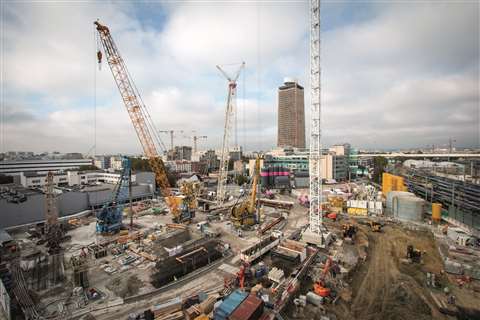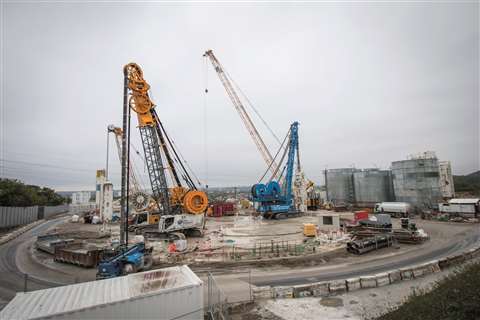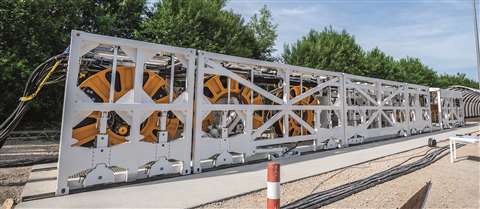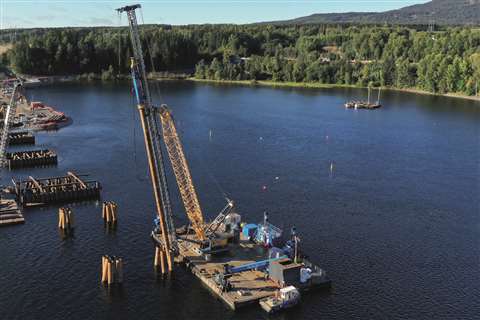How these infrastructure projects sparked foundations innovation
03 November 2021
In construction, nothing goes up before first going down. Mike Hayes looks at some foundations challenges and their imaginative solutions
In France, one of the largest and most ambitious infrastructure projects in Europe is ongoing – the Grand Paris Express.
When completed, the new metro network will reduce road traffic in the French capital, improve air quality and, hopefully, make the lives of Parisians a little easier.
The project encompasses the extension of line 14 of the metro and the construction of new lines 15, 16, 17 and 18. Along with approximately 200km of new lines, some 60 new stations are being constructed. In total, the planned investment for the network is more than €35 billion.
 The complexity and requirement for cutting edge construction technology in Trevi’s work on the Grand Paris Express project is staggering.
The complexity and requirement for cutting edge construction technology in Trevi’s work on the Grand Paris Express project is staggering.
Trevi Group
Undertakings of this magnitude can only be built on the most robust foundations, which is where the Trevi Group comes into the equation.
The company is undertaking foundation work as part of the construction of the underground stations of Paris’ Le Bourget Airport, Aulnay and Saint-Denis Pleyel, set to be the largest of all the Grand Paris Express stations and crossed by tunnels of lines 14, 15 and 16.
Marcello Varese, project director at the Saint-Denis Pleyel station says it is “the main station of the whole Grand Paris project, as it connects four metro lines with two railway lines and is located near the Stade de France [the national sports stadium of France].”
What makes the station unique is its 9000m2 surface area, as well as the fact that Trevi is undertaking excavation here using the ‘top down’ method. In fact, in order to allow the ‘top down’ excavation, it was necessary for the company to add 36 plunge columns, which allow simultaneous superstructure construction and basement excavation.
So, not only did Trevi construct 141 structural diaphragm wall panels, it also fabricated 36 plunge columns, each weighing 90 tonnes and which had to be laid to a depth of 36m. According to Trevi, this is a first.
Grand Paris Express Project
Trevi is undertaking groundwork across the Grand Paris Express project, with one of the first items on the agenda being land treatment; consolidating the treated soil and significantly lowering the level of groundwater to ensure tunnels can be excavated safely.
 Trevi utilising the foundation drilling equipment of its subsidiary company Soilmec during construction work on the Grand Paris Express.
Trevi utilising the foundation drilling equipment of its subsidiary company Soilmec during construction work on the Grand Paris Express.
Trevi is also involved in the excavation of a number of service shafts by tunnel boring machines (TBM), which will allow access for rescue and evacuation of passengers, ventilation and power supply.
These shafts run to significant depths and require the construction of reinforced retaining walls through diaphragm walls that can sometimes reach more than 60m in depth.
For these applications, Trevi is using drilling equipment including advanced heavy-duty buckets and hydromills.
Bauer Maschinen
Just as the Grand Paris project attempts to future-proof the capital city, in terms of transportation, Bauer Maschinen is looking to the future of megacities with its latest technology.
In cooperation with construction firm Denys, Bauer has developed the ‘Cube system’ of underground cutting equipment, which allows for the construction of, for example, subway stations, in busy urban areas, with greatly reduced noise, dust and traffic upheaval.
The cube milling system is based on Bauer’s existing cutting technology, but with the cutters fitted into a container-sized frame, which can be individually lowered into a shaft.
 Bauer says its new Cube system will open up completely new application possibilities in the production of diaphragm walls in the future.
Bauer says its new Cube system will open up completely new application possibilities in the production of diaphragm walls in the future.
The cube system can then progress along microtunnels with diameters as small as 3.8m, milling diaphragm walls.
Dr Rüdiger Kaub, managing director of Bauer Maschinen, says, “Imagine you’re planning a new subway line in a densely populated metropolis.
“With our BAUER Cube System…this is now possible. It can be used exactly where the new subway station is to be built: underground – under the existing buildings!
“This opens up completely new possibilities for planners and architects.”
The Cube system is still being tested by Bauer and Denys, but is expected to be fully developed and launched before the end of this year.
Where laying foundations is challenging on land, on the water things can get complicated in the extreme.
Norway’s longest railway bridge
Such is the case with the foundations for Norway’s longest railway bridge over the River Vorma in Minnevika, which is being undertaken by Aarsleff Ground Engineering.
Aarsleff was engaged by PNC, a company owned by Porr, to carry out the piling works for the foundations of the bridge. The construction consists of 20 pier shafts with 280 friction piles, which Aarsleff has to drive into the ground.
Dennis Jensen, senior project manager with Aarsleff, says, “Before rail traffic is permitted, the piles must rest for at least two years. The design challenge lay in achieving the ground-bearing capacity because the rock lies so deep, therefore inclined piles were required. The project is situated in an inland lake, which makes the transportation of large machines and large materials much more difficult.”
Aarsleff decided to us a Liebherr LRH 600 piling rig with fixed leader system for the task. Jensen says, “We decided for this machine because of the possible hammer sizes for inclined piles. It is very strong and stable.
 Constructing the foundations for the railway bridge in Norway, Aarsleff was impressed with the stability of the piling rig on the jack-up barge.
Constructing the foundations for the railway bridge in Norway, Aarsleff was impressed with the stability of the piling rig on the jack-up barge.
“We have to drive in the piles with an inclination of up to 1:5 and the hammer size was an important requirement both for Aarsleff and also the capacity of the LRH 600. Liebherr was the only supplier that could fulfil our technical requirements with a short notice and deliver a carrier machine and leader as a complete package.”
Aarsleff brought in a Liebherr HS 895 HD duty cycle crawler crane as the carrier machine, positioning it on a barge, from which the rig has to drive half of the piles into the bed of the river.
Each of these mighty piles is 58m long, with a diameter of 1016mm and a weight of 29 tonnes.
Jensen says, “The stability of the piling rig on the barge is surprising. Even with strong currents we can position the piles within the tolerances specified for the project in water 12-14 m deep.”
STAY CONNECTED



Receive the information you need when you need it through our world-leading magazines, newsletters and daily briefings.
CONNECT WITH THE TEAM








